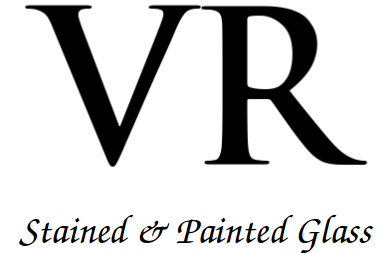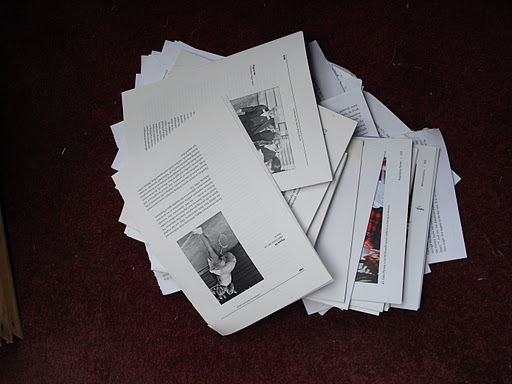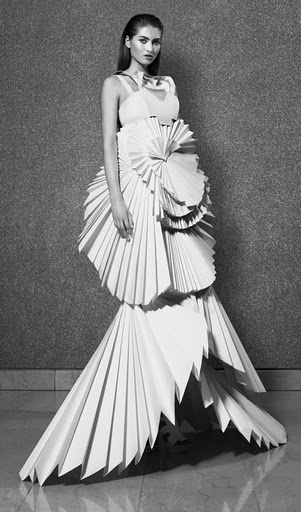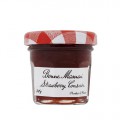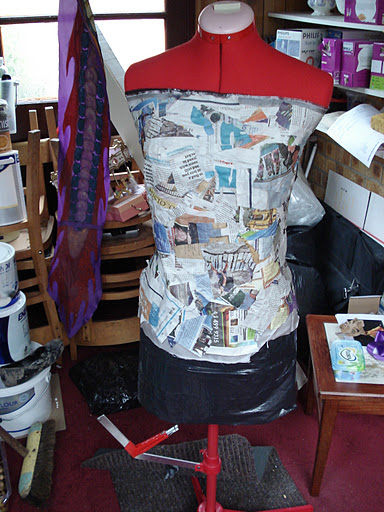 After looking at all the dresses that had been made previously I decided to change some elements while keeping some of the things that worked well and keeping the feel of the original dress that started all this off. Once I’d picked up the materials, my ideas on the design were also influenced by them. One of the first things to catch my eye was two books of Japanese translations. One was quite a minimalist font whereas the other used more bold characters. In each case however because of the chartacters the paper had a softer look. On comparison with some of the other books the paoer itself appeared also less white tending to wander into pinky/dusty tones. I thought this would be fantastic for the bodice but wasn’t sure it would be strong enough on its own. Plus as the dress is intended to be worn what would the comfort be like? The soloution to this came from good old newspaper paper mache. Using a fabric offcuts of a silver gown I’d previously made pinned onto Margo (my dress form) as a base and marker of where the bodice should fit to it was possible to sculpt a paper mache base (this part took quite some time to complete as I had to experiment with different glue strengths as trying to get the news paper and fabric to bond was a bit tough). Once that had dried the japanese paper could be applied to the top and when this was complete I experiemented with other original details (like lacing at the back of the dress, a shoulder strap and oriental lillies made out of paper and beads) could be added. The skirt presented yet more challenges. First of all in regard to length (I had originally envisioned a to the floor skirt with a 1800 type shape (like a slim bell really) in monotone with a split down the back, so colour pages could come flooding out) having shown this idea to Berg we decided on a shorter length because it had to be worn and transported. Also the addition of the multicoloured flowers/shoulder detail on the bodice meant that for the gown to flow colour had to be injected into the skirt at regular intervals. The next challenge was movement; quite a few of the designs that I had seen seemed to favour a fixed/static skirt.
After looking at all the dresses that had been made previously I decided to change some elements while keeping some of the things that worked well and keeping the feel of the original dress that started all this off. Once I’d picked up the materials, my ideas on the design were also influenced by them. One of the first things to catch my eye was two books of Japanese translations. One was quite a minimalist font whereas the other used more bold characters. In each case however because of the chartacters the paper had a softer look. On comparison with some of the other books the paoer itself appeared also less white tending to wander into pinky/dusty tones. I thought this would be fantastic for the bodice but wasn’t sure it would be strong enough on its own. Plus as the dress is intended to be worn what would the comfort be like? The soloution to this came from good old newspaper paper mache. Using a fabric offcuts of a silver gown I’d previously made pinned onto Margo (my dress form) as a base and marker of where the bodice should fit to it was possible to sculpt a paper mache base (this part took quite some time to complete as I had to experiment with different glue strengths as trying to get the news paper and fabric to bond was a bit tough). Once that had dried the japanese paper could be applied to the top and when this was complete I experiemented with other original details (like lacing at the back of the dress, a shoulder strap and oriental lillies made out of paper and beads) could be added. The skirt presented yet more challenges. First of all in regard to length (I had originally envisioned a to the floor skirt with a 1800 type shape (like a slim bell really) in monotone with a split down the back, so colour pages could come flooding out) having shown this idea to Berg we decided on a shorter length because it had to be worn and transported. Also the addition of the multicoloured flowers/shoulder detail on the bodice meant that for the gown to flow colour had to be injected into the skirt at regular intervals. The next challenge was movement; quite a few of the designs that I had seen seemed to favour a fixed/static skirt.
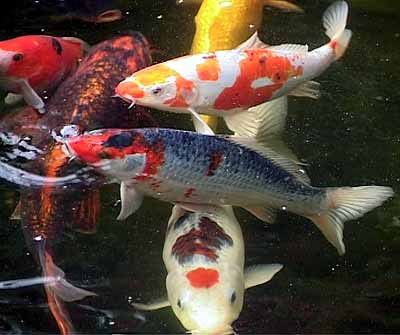 Anyone who has ever knocked a pile of paper over (I’m thinking most of you) would know that paper is anything but static, I wanted my dress to move, but the pages had to attach to each other somehow… it was only when I was out at a garden centre that the idea hit me. We were looking at some beautiful (and being fully grown, expensive) Koi Carp and in particular how their scales lock into each other, being fixed but allowing the fish to move freely. Could the idea of that be translated into my dress?
Anyone who has ever knocked a pile of paper over (I’m thinking most of you) would know that paper is anything but static, I wanted my dress to move, but the pages had to attach to each other somehow… it was only when I was out at a garden centre that the idea hit me. We were looking at some beautiful (and being fully grown, expensive) Koi Carp and in particular how their scales lock into each other, being fixed but allowing the fish to move freely. Could the idea of that be translated into my dress?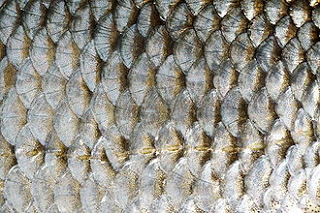 With the fish scales idea firmly planted in my mind I decided to start expeimenting with my skirt, making ‘scales’ of paper that were uniform, but different patterns and attaching only the top corner of these so that their movement would be retained. The story book dress on the previous post features sewn pages, after a trial of how that worked (it did until you applied some serious weight) and calculating how long it would take it I decided that a glue gun would probably provide a better solution. So after sourcing a variety of different books/colours and cutting all the pages to size, graduating them slightly as they went down the skirt I starting the constuction at the bottom. Within 20 squares/1 hour (which was about half a side) I had burned myself quite badly on a finger on my left hand (and this was supposed to be a special safer glue gun!). As I was teaching violin at a band workshop at Towersey music festival (for which fingers would be a distinct advantage), it was decided that no more glueing should take place in case I burnt myself again, so Jam being manly and heroic stepped into the breech, and for quite a few evenings we sat in my makeshift studio at the back of the house, me picking the squares and showing where they should go, Jam doing the glueing. Now it’s nearly finished and I will unveil on Monday 🙂
With the fish scales idea firmly planted in my mind I decided to start expeimenting with my skirt, making ‘scales’ of paper that were uniform, but different patterns and attaching only the top corner of these so that their movement would be retained. The story book dress on the previous post features sewn pages, after a trial of how that worked (it did until you applied some serious weight) and calculating how long it would take it I decided that a glue gun would probably provide a better solution. So after sourcing a variety of different books/colours and cutting all the pages to size, graduating them slightly as they went down the skirt I starting the constuction at the bottom. Within 20 squares/1 hour (which was about half a side) I had burned myself quite badly on a finger on my left hand (and this was supposed to be a special safer glue gun!). As I was teaching violin at a band workshop at Towersey music festival (for which fingers would be a distinct advantage), it was decided that no more glueing should take place in case I burnt myself again, so Jam being manly and heroic stepped into the breech, and for quite a few evenings we sat in my makeshift studio at the back of the house, me picking the squares and showing where they should go, Jam doing the glueing. Now it’s nearly finished and I will unveil on Monday 🙂